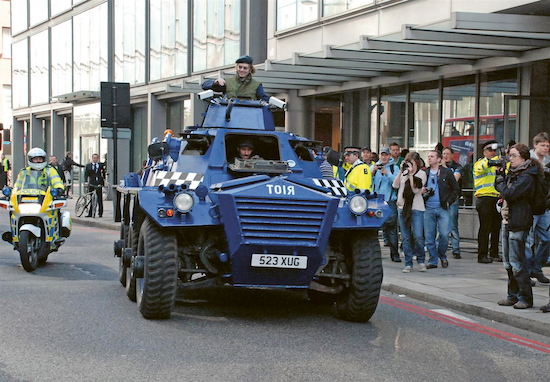Credit: Space Hijackers. During the G20 summit protest in London in April 2009, the Space Hijackers decided to bring a fake riot tank to the disobedient party. However, the Metropolitan Police failed to see the funny side and charged all 11 Hijackers with impersonating police officers
It’s the summer of 1971 and tourists flock around one of Washington DC’s most famous hotspots – the Capitol steps. Journalist Art Goldberg recalls ‘a squad of soldiers moving through the space. They are grubby-looking troopers, clad in jungle fatigues. Jumping a low fence, they begin shouting at a group of tourists. “All right! Hold it! Hold it! Nobody move. Nobody move!” Their voices full of tension and anger. A man runs from the crowd. Several soldiers fire, and the man falls, clutching his stomach. Blood can be seen. The tourists turn away in horror. “Get a body count,” a soldier yells. Suddenly, another squad of soldiers emerge. “All right! ID! ID!” they screech. They quickly grab a young woman and lead her away, binding her wrists and prodding her with rifles. The soldiers leave and more men in khaki fatigues pass out leaflets to the astonished tourists. “A US Infantry platoon just passed through here!” the pink paper reads. “If you had been Vietnamese … we might have burned your house. We might have shot your dog. We might have shot you … HELP US END THE WAR BEFORE THEY TURN YOUR SON INTO A BUTCHER OR A CORPSE.”’ The anti-war group Vietnam Veterans Against the War was behind the intervention: the art of guerrilla theatre had arrived.
Guerrilla theatre is a form of intervention where acts of spontaneous, surprise performance in unlikely public spaces rupture the boring-as-shit, day-to-day reality for an unsuspecting audience. Not all forms of guerrilla theatre are as intense as the example above, but most performances draw attention to a political or social issue through satire, protest and carnivalesque techniques. Many of the early performances were a direct result of the radical social movements of the late 1960s to mid-1970s. In Brazil and Argentina in the 1970s, theatre practitioner Augusto Boal developed a form of performance that he called ‘invisible theatre’. The purpose of invisible theatre was to show oppression in everyday life, in an everyday setting, without the audience knowing.
Often performed with secret actors in cafés or shops, invisible theatre was an extension of the ‘happenings’ that were pioneered in New York during the 1960s to raise awareness of social issues outside the traditional theatre or gallery. Guerrilla theatre is best seen as the disruptive, but loveable, offspring of invisible theatre and happenings, following a creative orgy lasting decades that had also involved carnivals, parades, pageants, creative activism and, most notably, the avant-garde Dada and later street art movements of the 1970s and 80s.
Fast forward to 1998. A middle-aged man with a newsreader-worthy bouffant quiff of golden hair is dressed in a white suit and black shirt adorned with a white priest’s collar. Groups of people are converging from multiple points in Times Square in New York. His hands reach up into the air, holding a Mickey Mouse toy duct-taped to a cross. The collar is fake, but the calling is real and Reverend Billy from the Church of Stop Shopping is about to drop a public exorcism at a Disney store. It’s a ‘Shopocalypse’, and customers don’t know what the fuck is going on. The Reverend stands up, announces that Mickey Mouse is the Antichrist and starts performing an exorcism, for believers and non-believers alike, on a cash register. Calling out sweatshop labour, consumerism and its impact on climate change and society at large, Reverend Billy’s public sermons have gone down in history as guerrilla theatre at its best. Tutored, originally, by a legit vicar in the Hell’s Kitchen neighbourhood of Manhattan, Billy uses many strategies, including retail interventions and mobile-phone operas, to engage unsuspecting audiences in serious social and environmental issues. In 2002, Starbucks issued a document to its workers entitled ‘What Should I Do if Reverend Billy Is in My Store?’ The document outlined an evacuation protocol and a series of scripted reassurances for workers to deliver to disturbed or inquisitive customers. Amen to that.

Credit: Billy Talen, 2015. Reverend Billy and the Stop Shopping Choir mid sermon in Times Square, New York
The use of carnivalesque forms of resistance was a key tactic developed during the global anti-capitalist mass actions of the 1990s. Art activists John Jordan, L.M. Bogad, Jen Verson and Matt Trevelyan founded the Clandestine Insurgent Rebel Clown Army (CIRCA) in late 2003 to welcome US arch-clown, George W. Bush, on his state visit to the UK. CIRCA aimed to offer a new methodology of civil disobedience, merging the ancient art of clowning with contemporary tactics of nonviolent direct action. It went on to be a successful meme and international protest phenomenon, with self-organized groups taking action in the streets outside summits and military bases in dozens of countries, from Colombia to New Zealand. Some of the clowns filled their pockets with loads of strange junk so that it took hours, and lots of paperwork, when ‘stop and searches’ occurred during protests.
Emma Goldman (1869–1940), a legendary anarcho-feminist, once declared, ‘If I can’t dance to it, it’s not my revolution,’ so it’s good to know that, since the 1950s, artists and collectives including Alan Kaprow, El Teatro Campesino, Augusto Boal’s Theatre of the Oppressed, Guerrilla Girls, Reverend Billy, the Yes Men, CIRCA, Liberate Tate and Improv Everywhere have ensured that the spirit of rebellion is alive and well while also making sure protest isn’t shit and boring.
Extracted from The Street Art Manual by Bill Posters, illustrated by Matt Bonner. Released 3rd September, laurenceking.com


